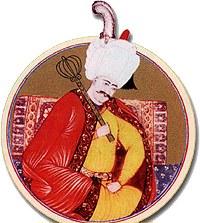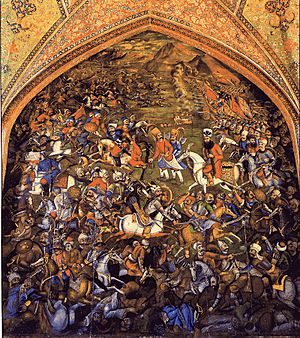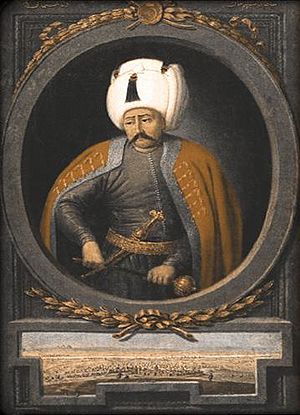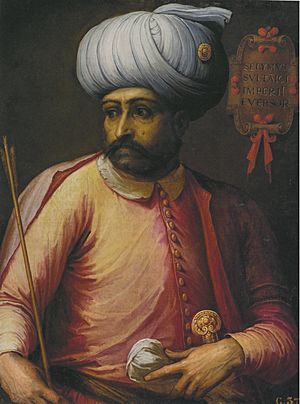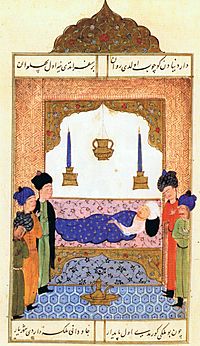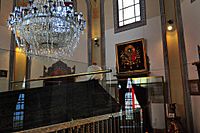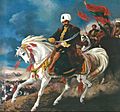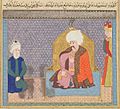Selim I facts for kids
Quick facts for kids Selim I |
|||||
|---|---|---|---|---|---|
| Kayser-i Rûm Ottoman Caliph Amir al-Mu'minin Custodian of the Two Holy Mosques |
|||||
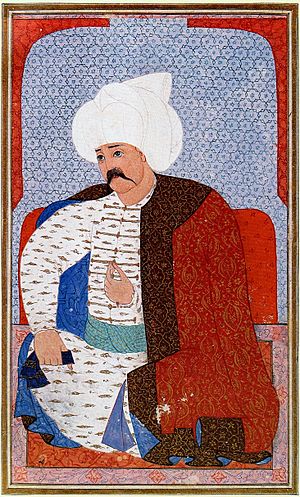
Selim I by Nakkaş Osman
|
|||||
| Sultan of the Ottoman Empire (Padishah) | |||||
| Reign | 24 April 1512 – 22 September 1520 | ||||
| Predecessor | Bayezid II | ||||
| Successor | Suleiman I | ||||
| Prince-Governor of Trebizond Sanjak | |||||
| Reign | 1487 – 1510 | ||||
| Born | 10 October 1470 Amasya, Ottoman Empire |
||||
| Died | 22 September 1520 (aged 49) Çorlu, Ottoman Empire |
||||
| Burial | Yavuz Selim Mosque, Fatih, Istanbul | ||||
| Consorts |
|
||||
| Issue |
|
||||
|
|||||
| Dynasty | Ottoman | ||||
| Father | Bayezid II | ||||
| Mother | Gülbahar Hatun | ||||
| Religion | Sunni Islam | ||||
| Tughra |  |
||||
| Battles/wars | Ottoman-Persian Wars
Georgian campaign (1508) Ottoman Civil War (1509–1513)
Ottoman–Mamluk War (1516–1517)
|
|---|
Selim I (Ottoman Turkish: سليم الأول; Turkish: I. Selim), born on October 10, 1470, was a powerful Sultan of the Ottoman Empire. He ruled for a short time, from 1512 to 1520. Despite his short reign of eight years, Selim I made the Ottoman Empire much bigger. He is often called Selim the Grim or Selim the Resolute (Turkish: Yavuz Sultan Selim).
Selim I conquered a huge area, including the entire Mamluk Sultanate of Egypt. This included places like Syria, Palestine, Hejaz, and Egypt itself. By the time he died in 1520, the Ottoman Empire had grown by 70 percent. It covered about 3.4 million square kilometers. His victories made the Ottoman Empire the most important Muslim state. He also became the guardian of the pilgrimage routes to the holy cities of Mecca and Medina.
Contents
Early Life and Family
Selim was born in Amasya around 1470. He was the youngest son of Bayezid II, who later became Sultan. His mother was Gülbahar Hatun, a Turkish princess. Some historians also suggest his mother might have been Ayşe Hatun.
Becoming Sultan
Governor of Trabzon
Before becoming Sultan, Selim was the governor of Trabzon. He became well-known for his military skills. He fought against the Safavid Empire and led campaigns in the Caucasus region against Georgia. In 1505, he defeated a Safavid army. He won against them again in 1507 at the Battle of Erzincan. In 1508, he invaded the Caucasus, bringing parts of western Georgia under Ottoman control. He also won another battle against the Safavids in Trabzon in 1510.
Taking the Throne
In 1512, Selim's father, Bayezid II, wanted his older brother, Şehzade Ahmed, to be the next Sultan. Selim was not happy about this. He led a rebellion against his father. Even though he lost the first battle, Selim eventually removed his father from power. This was the first time an Ottoman prince openly fought his father with an army. Selim then sent his father away. After becoming Sultan, Selim made sure his brothers and nephews would not challenge his rule. This was a common practice to prevent civil wars.
Expanding the Empire
Conflict with the Safavid Empire
One of Selim's first big challenges was the growing power of the Safavid Empire. This empire was led by Shah Ismail. Shah Ismail had changed the state religion of Persia to a different branch of Islam called Shia Islam. By 1510, he had conquered many lands, including all of Iran. He was seen as a threat to the Sunni Muslim Ottoman Empire.
In 1514, Selim I attacked Shah Ismail's kingdom. He wanted to stop the spread of Shia Islam into Ottoman lands. Before the attack, Selim and Ismail exchanged angry letters. Selim's army defeated Ismail's forces at the Battle of Chaldiran in 1514. The Ottomans won because they had a more modern army with artillery and muskets. Shah Ismail was hurt in the battle. Selim I entered the Safavid capital of Tabriz in victory. This battle was very important because it showed the power of modern firearms.
Conquering the Middle East

Selim then turned his attention to the Mamluk Sultanate of Egypt. He defeated the Mamluk Egyptians in two major battles: the Battle of Marj Dabiq in 1516 and the Battle of Ridanieh in 1517. These victories meant the Ottoman Empire took over the entire Mamluk Sultanate. This included Syria, Palestine, Hejaz, and Egypt.
This expansion allowed Selim to control the Muslim holy cities of Mecca and Medina. These cities were previously under Egyptian rule. Selim chose the humble title Ḫādimü'l-Ḥaremeyn, meaning The Servant of The Two Holy Cities, rather than The Ruler of The Two Holy Cities. After taking Damascus in 1516, Selim also ordered the repair of the tomb of Ibn Arabi, a respected Sufi master.
Selim's Personality and Legacy
Selim was known for having a strong personality and high expectations. He was very energetic and hardworking. During his short eight years as Sultan, he achieved great success. Many historians believe that Selim's conquests prepared the Ottoman Empire for its greatest period under his son, Suleiman the Magnificent.
Selim was also a talented poet. He wrote poems in both Turkish and Persian under the name Mahlas Selimi. Some of his Persian poems still exist today.
Relations with Other Leaders
Economic Conflict with Persia
Besides military battles, Selim I and Shah Ismail also had economic conflicts. Selim I did not approve of Shah Ismail's Shia beliefs. After the Battle of Chaldiran, Selim I closed the borders with the Safavid Empire. He wanted to cut off trade between the Safavid Empire and the rest of the world.
Even though the Ottoman Empire needed silk from Persia, Selim put a strict ban on Iranian silk. He hoped this would hurt the Safavid economy. Merchants who did not leave Ottoman territory when the war started had their goods taken and were put in prison. This strict policy was changed by his son, Suleiman I, after Selim's death.
Relations with Babur
At first, Selim I's relationship with Babur, who later founded the Mughal Empire in India, was not good. Selim I had helped Babur's rival with weapons. However, in 1513, Selim I and Babur became allies. Selim sent Ottoman experts to help Babur with his conquests. These experts taught Babur how to use modern firearms like matchlocks and cannons in battles. This help was very important for Babur's future success in India.
Death
Selim I had planned more military campaigns, but he became very sick and died at the age of 49. Officially, it is said he died from a severe skin infection called a carbuncle. Some historians think he might have died from cancer or even poisoning. Other historians note that a plague was common in the empire at that time, and Selim might have suffered from it.
Selim I died on September 22, 1520. He was buried in the Yavuz Selim Mosque in Istanbul. This mosque was built by his son, Sultan Suleiman the Magnificent, in his father's memory. Selim I had united and protected many Islamic lands. He focused on the East, believing that the biggest dangers came from there.
Family Life
Wives
Selim I had two known wives:
- Hafsa Hatun: She was his favorite and the mother of his successor, Suleiman the Magnificent. She became the first Valide Sultan, a very important title for the Sultan's mother.
- Ayşe Hatun: She joined Selim's family after her first husband died in 1507.
Children
Selim had several children, including:
- Suleiman the Magnificent: He became the 10th Sultan of the Ottoman Empire.
- Üveys Pasha: An illegitimate son who became the governor of Yemen.
- Many daughters, including Fatma Sultan, Hatice Sultan, Hafize Hafsa Sultan, and Şah Sultan.
Legacy and Culture
- A modern drillship, the Yavuz, is named after Selim I.
- A large bridge over the Bosphorus in Istanbul is called the Yavuz Sultan Selim Bridge.
In Popular Culture
- Selim I appears as a character in the video game Assassin's Creed: Revelations.
- He is also shown in the Turkish historical TV series Magnificent Century.
- Selim I is a main character in the Saudi-Emirati series Kingdoms of Fire.
Images for kids
-
Yavuz Selim Mosque was commissioned by the Ottoman sultan Suleiman I in memory of his father Selim I who died in 1520. The architect was Alaüddin (Acem Alisi).
See Also
 In Spanish: Selim I para niños
In Spanish: Selim I para niños
- Tuman bay II
- Al-Mutawakkil III


